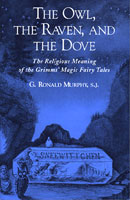Reviews
The Owl, The Raven, and The Dove:
The Religious Meaning of the Grimms' Magic Fairy Tales

The Owl, The Raven, and The Dove: The Religious Meaning of the Grimms' Magic Fairy Tales.
G. Ronald Murphy. Oxford University Press, 2000. xi + 208 pp.,
ISBN-13: 978-0195136074

[This review originally appeared in Mythprint 39:7 (#244) in July 2002.]
"And then I picked it up. A strange feeling came over me about looking into another person's private religious thoughts, feelings which had occurred a hundred and fifty years ago. Then I opened it, and a small shower of dark dried flower petals, color long gone, fell into my lap ..." (pp. 37-38). It must have been a fairy-tale like moment for G. Ronald Murphy, S.J. (Professor of German at Georgetown University), his opening of Wilhelm Grimm's Greek New Testament. I experienced a similar sense of discovery in reading Murphy's book; it was one of the most satisfying and thought-provoking books of scholarship I have read in a while.
This book is an interpretation of the Grimms' fairy tales but quite a bit different from "approaches that are Jungian, Marxist, socio- political, dialectical, historical, text-historical, feminist, gender-related, mythological, and economic ..." (p. vii). It is a spiritual study that focuses on the brothers' intentional attempt to infuse the stories with spiritual allusions to Greek, Germanic, and Christian belief systems.
The first three chapters deal with an introduction to and underpinnings for the following chapters that discuss five of the tales. Chapter One, "The Roots of Spiritual Stories", deals mainly with two works, The Heliand (a retelling of the Gospel from a Germanic background), and Wolfram von Eschenbach's Parzival. The brothers were interested in how the works blended Christian themes and Germanic literary forms. In the second chapter, "Scholars and the Religious Spirit of the Tales", Murphy comments on Bruno Bettelheim's The Uses of Enchantment, the Meaning and Importance of Fairy Tales. He quotes Bettelheim (p. 228): "Most fairy tales of the western world have at some time included Christian elements, so much so that an account of those underlying Christian meanings would make another book" (Murphy, p. 18). He also discussed Heinz Rölleke's textual/historical criticism, which finds four categories of how the deity is present in the tales, but implies that the oldest forms would be devoid of Christianity. Murphy comments, "For me it is the stories as rewritten ... that charm us all with diachronic religious magic." (p. 21). The rest of the chapter argues that it is the Grimms' rewriting and infusion of Greek, Germanic and Christian themes that gives their tales such power.
The third chapter, "The Spirituality of Wilhelm Grimm", discusses the Reformed background of the brothers. Both their father and grandfather were preachers in their home town of Steinau. By looking at study Bibles used by Wilhelm, Murphy identifies themes of importance to him, e.g. the Holy Spirit, love one another, humble faith. In the following chapters, Murphy illustrates how Wilhelm incorporated these themes into the fairy tales.
"At that moment, they heard from behind them a loud noise -- a great cracking, deafening noise as if a giant had broken a giant's plate." That quote from C.S. Lewis¹s The Lion, the Witch, and the Wardrobe is the famous resurrection of Aslan. To a person who knows Christian symbolism it seems quite obvious. But to most people, whether or not they are aware of the background, it is still a powerful text. The Grimm fairy tales are also powerful in themselves, but once the Greek, Germanic and Christian religious elements are identified, the tales take on even deeper meaning. In the last chapters of the book, Murphy goes through five individual tales contrasting them with other versions (such as Perrault's) and pointing out the religious themes.
In the chapter on "Little Red Riding Hood," the change from Perrault's basket of bread and butter to the Grimms' bread and wine shows the amplification of meaning (the Eucharist) by "rewriting" it with Christian symbolism. When it comes to Germanic symbolism, the wolf is seemingly obvious (Fenrir) but the Grimms once again, unlike Perrault, mix in other symbols. Rather than the grandmother living "beyond that mill ... the first house in the village" (p. 69), the Grimms place her "farther in the woods ... under the three great oak trees . . . [with] hazel-nut hedges." (p. 69) Woods, three oak trees and hazelnuts are all powerful symbols in the Germanic mythos and their inclusion enriches the story. Finally, instead of the wolf simply eating Little Red Riding Hood, end of story, as in Perrault, the Grimms include not only a salvation story (the killing of the wolf by the huntsman and the rebirth of the child and grandmother) but also an interesting allusion to Greek myth. Grimms' Little Red Riding Hood fills the wolf's belly with stones, just as Rhea feeds a stone to Chronos in Greek mythology, thereby saving her child's life and leading to the later "rebirth" of the gods.
This is only a hint of the depth in which Murphy examines the Grimms' enrichment of the tale of "Little Red Riding Hood." He also sifts through the stories of "Hansel and Gretel," "Cinderella," "Snow White" and "Sleeping Beauty" in further chapters.
This book was a real eye-opener for me. Murphy has the insight to point out elements that, once identified, seem obvious. He also demonstrates how, rather than being a detriment (as some have suggested), the Grimms' rewriting of the tales makes them so much richer in imagery and meaning. I would highly recommend this book to anyone interested in a deeper understanding of the wonder brought by reading "simple" fairy tales.
—Eric Rauscher
Content copyright 1967- The Mythopoeic Society All rights reserved
